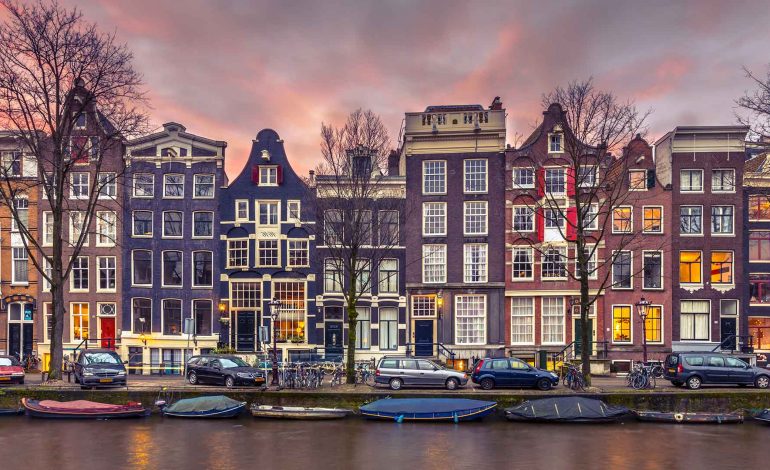Amsterdam Ousts London as Europe’s Top Trading Hub
- By Sarah Wilson
- February 2, 2024

Have you ever wondered how a small trading post nestled in the marshlands of the Netherlands evolved into Europe’s leading trading hub?
From the innovative engineering masterpiece of its canals to the bustling markets that attracted merchants from far and wide, Amsterdam’s transformation is nothing short of remarkable.
Discover how the city’s merchant associations paved the way for elite financial institutions and set the stage for Amsterdam to become an international financial powerhouse. From its Golden Age to the present day, we’ll trace the city’s enduring legacy as a nucleus of commerce and entrepreneurship.
The Early Beginnings: From Swampland to Trade Routes
Amsterdam’s journey as Europe’s leading trading hub can be traced back to its humble beginnings in the
12th century. Situated in a marshy landscape, the city’s geographical location seemed unfit for a prosperous trading center. However, ambitious pioneers recognized the potential of the area and transformed it into what we now know as Amsterdam.
The Dam that Changed Everything: In the
13th century, the construction of a dam on the river Amstel was a pivotal moment for the city’s development. This dam provided control over the water flow, draining the swampland and allowing for land reclamation, creating a stable foundation for future growth.
The Convenient Connection: The strategic positioning of Amsterdam between the North Sea and the river network of the Netherlands made it an ideal crossroads for trade. Merchants and traders from neighboring towns and countries were drawn to Amsterdam’s convenient access to both maritime and inland transportation.
The Hansa League’s Influence: In the
14th century, Amsterdam became a key member of the Hanseatic League, a powerful trading alliance that spanned Northern Europe. As a member, the city enjoyed exclusive trading rights and access to a vast network of merchants, further boosting its economic prospects.
The Rise of Dutch East India Company: The
17th century marked a significant turning point in Amsterdam’s trading history. The establishment of the Dutch East India Company (VOC) in
1602 skyrocketed Amsterdam’s prominence as a global trading hub. The VOC played a crucial role in Dutch colonial expansion and monopolized trade with the East Indies, bringing immense wealth to the city.
Amsterdam’s Strategic Geographical Location
Amsterdam’s rise as Europe’s leading trading hub can be attributed, in large part, to its strategic geographical location. Situated in the western part of the Netherlands, Amsterdam has access to both the North Sea and major rivers such as the Rhine and the Meuse. This advantageous location has made it a crucial center for maritime trade and transportation throughout history. Let’s explore the key factors that have contributed to Amsterdam’s strategic location and its impact on trade.
Port Accessibility
Amsterdam’s location at the mouth of the River Amstel, which flows into the IJ Bay, provides direct access to the North Sea. This proximity allows ships to easily navigate in and out of the port, facilitating the efficient movement of goods. The port of Amsterdam has been continuously expanded and modernized over the years, further improving its capacity to handle large volumes of cargo. In fact, it is now one of the largest ports in Europe.
Navigable Waterways
The presence of extensive and interconnected waterways, including canals and rivers, has been instrumental in facilitating trade within and outside of Amsterdam. The city’s famous canal system, built during the Dutch Golden Age, provides a comprehensive network of water routes that connect the city to surrounding regions and beyond. These waterways have served as vital arteries for transporting goods, further enhancing Amsterdam’s status as a trading hub.
Proximity to Europe’s Markets
Amsterdam’s central location within Europe has positioned it as a gateway to the continent’s markets. With its well-developed transportation infrastructure, including rail networks and highways, Amsterdam offers excellent connectivity to other major European cities and countries. This accessibility has contributed to the city’s attractiveness for international trade, attracting businesses and investors from around the world.
Free Trade Tradition
Amsterdam has a long-standing tradition of embracing free trade. Historically, the city has been known for its lenient trade regulations, fostering an environment conducive to commerce and entrepreneurship. This open and liberal approach has attracted merchants and traders seeking opportunities and has contributed to the city’s economic growth.
If you require assistance in finding European candidates from the Netherlands, you can contact Retained Headhunters. They have offices in the UK and the Netherlands.




